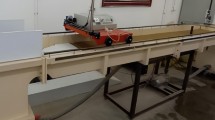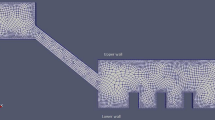Abstract
In this paper, the scour hole dimensions around submerged and emerged spur dike in a 90° bend along with the mean and turbulent flowfield were investigated experimentally. Two types of re-circulating flow at the downstream of the spur dike and around the spur dike wing were observed. A direct relation between the estimated bed shear stress using TKE and the scour process prevails. More attentions is needed in estimating the bed shear stress using vertical velocity fluctuations. The scour hole dimensions increase by increasing the ratio of radius of channel bend to channel width, the Froude number of the spur dike, ratio of the length of spur dike to channel width and ratio of the approach mean flow velocity to the approach flow velocity at threshold condition. However, vice versa trends were observed by increasing ratio of the spur dike length to the median sediment size, ratio of the wing length of spur dike to the length of spur dike and the submergence ratio. A particular location of the spur dike in the sharp bend was specified beyond which the scour hole dimensions increase. The ratio of the spur dike length to the median sediment size has a secondary effect on the scour hole dimensions. New equations are proposed for prediction of the scour hole dimensions considering the submergence ratio along with other effective parameters.













Similar content being viewed by others
Abbreviations
- a :
-
Scour width (m)
- B :
-
Distance from outer bank (m)
- c :
-
Scour length (m)
- d 50 :
-
Median size of the sediment (m)
- d sm :
-
Maximum scour depth (m)
- g :
-
Acceleration due to gravity (m/s2)
- h :
-
Height of the spur dike above the bed (m)
- k u1, k u2, x :
-
Constants in velocity threshold estimation equation (−)
- L :
-
Spur dike length (m)
- L :
-
The wing length of the spur dike (m)
- Ø :
-
Scour hole dimensions (m)
- R :
-
Bend radius (m)
- s :
-
Submergence ratio (Y − h)/h (−)
- s 0 :
-
Channel slope (−)
- U :
-
Mean velocity of the approach flow (m/s)
- u :
-
Mean velocity component in tangential direction (m/s)
- u’ :
-
Velocity fluctuation in tangential direction (m/s)
- u c :
-
Mean approach flow velocity at threshold condition (m/s)
- v :
-
Mean velocity component in radial direction (m/s)
- w :
-
Men velocity component in vertical direction (m/s)
- w’ :
-
Velocity fluctuation in vertical direction (m/s)
- Y :
-
The depth of the approach flow (m)
- α :
-
Section angle with respect to the beginning of the bend
- θ :
-
The location of the spur dike in the bend (°)
- ν :
-
Kinematic viscosity of the fluid (m2/s)
- ρ :
-
Density of fluid (kg/m3)
- ρ s :
-
Density of sediment (kg/m3)
References
Ahmad M (1951) Spacing and protection of spurs for bank protection. Civil Eng Publ Rev 46:537–538
Garde RJ, Subramanya K, Nambudripad KD (1961) Steady of scour around spur-dikes. J Hydraul Div 87(6):23–38
Gill MA (1972) Erosion and sand beds around spur dikes. J Hydraul Div 98(9):1587–1602
Richardson EV, Stevens MA (1975) The design of spurs for river training. In: Proc. 16th IAHR Congress, Sao Paolo-Brazil, pp 382–388
Lim SY, Tong KP (1991) On estimation of maximum scour around spur dike. In: Proceedings of the XXIV IAHR Congress, Madrid–Spain, pp 563–570
Kuhnle RA, Alonso CV, Shields FD (1999) Geometry of scour holes associated with 90° spur dikes. J Hydraul Eng 125(9):972–978
Kothyari UC, Ranga Raju KG (2001) Scour around spur dikes and bridge abutments. J Hydraul Res 39(7):367–374
Kuhnle RA, Alonso CV, Shields FD (2002) Local scour associated with angled spur dikes. J Hydraul Eng 128(12):1087–1093
Pagliara S, Hassanabadi L, Kurdistani SM (2015) Clear water scour downstream of Log deflectors in horizontal channels. J Irrig Drain Eng. doi:10.1061/(ASCE)IR.1943-4774.0000869
Giri S, Shimizu Y, Surajata B (2004) Laboratory measurement and numerical simulation of flow in a meandering-like flume with spurs. Flow Meas Instr 15(5–6), 301–309
Fazli M (2006) Scour and flowfield around a straight spur dike in 90° bend. PhD Thesis, Faculty of Civil and Environmental Engineering, Tarbiat Modares University, Tehran
Vaghefi M (2010) Scour formation around a T-shaped spur dike in 90ͦ bend. PhD Thesis, Faculty of Civil and Environmental Engineering, Tarbiat Modares University, Tehran
Elawady E, Michiue M, Hinokidani O (2000) Experimental study of flow behavior around submerged spur-dike on rigid bed. Annu J Hydraul Eng 44:539–544
Elawady E, Michiue M, Hinokidani O (2001) Movable bed scour around submerged spur-dikes. Annu J Hydraul Eng 45:373–378
Kuhnle RA, Jia Y, Alonso CV (2008) Measured and simulated flow near a submerged spur dike. J Hydraul Eng 134(7):916–924
Rodrigue-Gervais K, Biron PM, Lapointe MF (2011) Temporal development of scour holes around submerged stream deflectors. J Hydraul Eng 37(7):781–785
Mehraein M, Noorbakhsh M, Najibi SA (2015) Turbulent flow structure around submerged T-shaped spur dike, the Modares. J Civil Eng 15(3):171–178 (Persian)
Duan JG (2009) Mean flow and turbulence around a laboratory spur dike. J Hydraul Eng 135(10):803–811
Duan J, He L, Wang G, Fu D (2009) Turbulent burst around experimental spur dike. Int J Sedim Res 26(4):471–786
Gu Z, Cao X, Jiao Y, Lu W, CFD models for simulating flow around spur dike group along urban riverways. Water Resour Manag 30(13):4559–4570. doi:10.1007/s11269-016-1436-1
Mehraein M, Najibi SA, Ghodsian M (2014) Location effect on near bed flow structure around a straight spur dike. In: Proceeding of 9th international symposium on ultrasonic Doppler methods for fluid mechanics and fluid engineering, pp 173–176
Mehraein M, Ghodsian M, Najibi SA (2014) Experimental investigation on the flow field around a spur dike in a 90° sharp bend. In: Proceeding of Riverflow Conference, pp 743–749
Novak P, Moffat A.I.B., Nalluri C, Narayanan R (2004) Hydraulic structures. Taylor & Francis, London
Melville BW, Coleman SE (2002) Bridge scour. Water Resources Publications, Colorado
Leschziner MA, Rodi W (1979) Calculation of strongly curved open channel flow. J Hydraul Div 105(10):1297–1314
Neill CR (1973) Guide to bridge hydraulics. University of Toronto Press, Toronto
Day RA, Liriano S, White RW (2001) Effect of tailwater depth and model scale on scour at culvert outlets, Water. Management 148(3):189–198
Goring D, Nikora V (2002) Despiking acoustic doppler velocimeter data. J Hydraul Eng 128(1):117–126
ASTM Standard C670 (2003) Standard practice for preparing precision and bias statements for test methods for construction materials. ASTM International, West Conshohocken
Gautam B (2008) Submergence effects on jet behavior in scour by a plane wall jet. Msc Thesis, Department of Civil and Geological Engineering, University of Saskatchewan, Saskatoon
Dey S, Barbhuiya AK (2006) Velocity and turbulent in a scour hole at a vertical-wall abutment. Flow Meas Instr 17(1):13–21
Biron PM, Robson C, Lapointe MF, Gaskin SJ (2004) Comparing different methods of bed shear stress estimates in simple and complex flowfields. Earth Surf Process Landf 29(11):1403–1415
Raudkivi AJ (1986) Functional trends of scour at bridge piers. J Hydraul Eng 112(1):1–13
Sheppard DM, Odeh M, Glasser T (2004) Large scale clear-water local pier scour experiments. J Hydraul Eng 130(10):957–963
Lee S, Sturm TW (2009) Effect of sediment size scaling on physical modeling of bridge pier scour. J Hydraul Eng 135(10):793–802
Safarzadeh A, Salehi Neyshabouri SAA, Ghodsian M, Zarrati AR (2010) Experimental study of head shape effects on shear stress distribution around a single groyne. In: International conference on fluvial hydraulic, 2010, Braunschweig, Germany, pp 651–657
Safarzadeh A, Salehi Neyshabouri SAA, Zarrati AR (2016) Experimental investigation on 3D turbulent Flow around straight and T-Shaped groynes in a flat bed channel. J Hydraul Eng. doi:10.1061/(ASCE)HY.1943-7900.0001144
Alemi M, Maia R (2016) Numerical simulation of the flow and local scour process around single and complex bridge piers., Int J Civil Eng. doi:10.1007/s40999-016-0137-8
Author information
Authors and Affiliations
Corresponding author
Rights and permissions
About this article
Cite this article
Mehraein, M., Ghodsian, M., Khosravi Mashizi, M. et al. Experimental Study on Flow Pattern and Scour Hole Dimensions Around a T-Shaped Spur Dike in a Channel Bend Under Emerged and Submerged Conditions. Int J Civ Eng 15, 1019–1034 (2017). https://doi.org/10.1007/s40999-017-0175-x
Received:
Revised:
Accepted:
Published:
Issue Date:
DOI: https://doi.org/10.1007/s40999-017-0175-x




